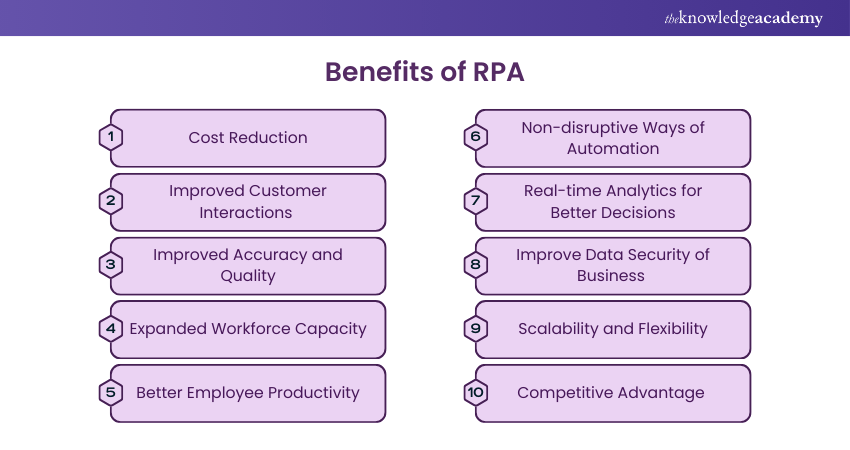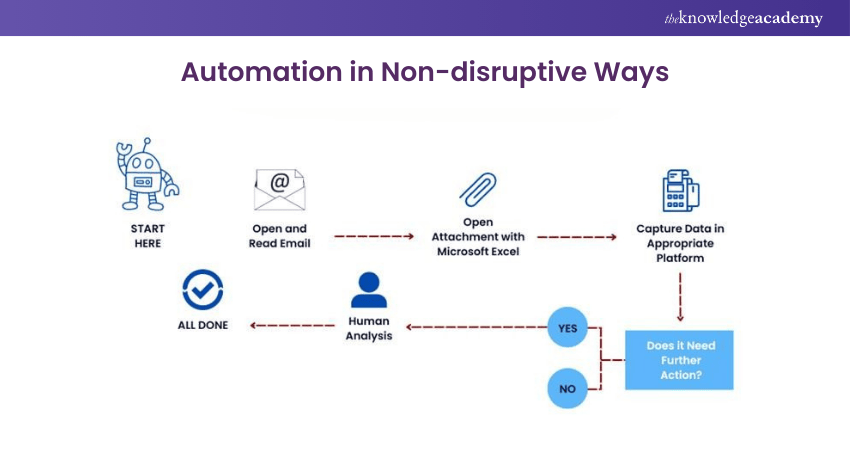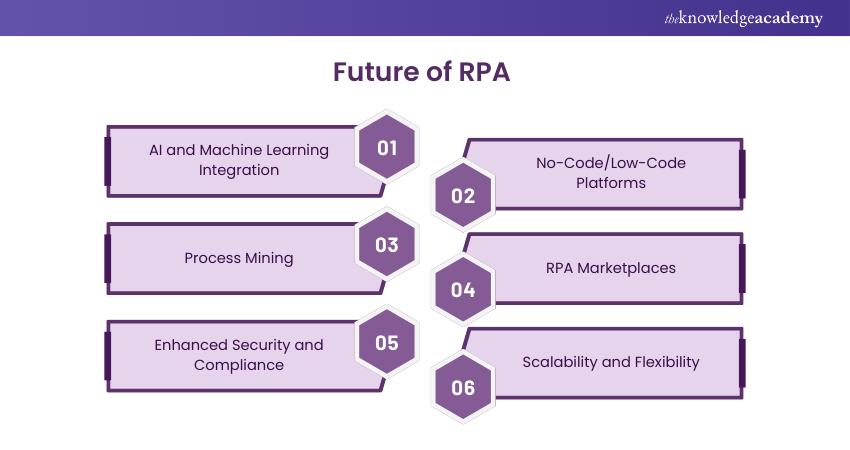We may not have the course you’re looking for. If you enquire or give us a call on +46 850282424 and speak to our training experts, we may still be able to help with your training requirements.
We ensure quality, budget-alignment, and timely delivery by our expert instructors.

Are you tired of repetitive tasks slowing down your business operations? What if you could automate these mundane processes and focus on what truly matters? The Benefits of RPA include transforming the way companies operate and unlocking new levels of efficiency and productivity.
In this blog, we’ll explore the key Benefits of RPA and how it can revolutionise your business operations. From cost reduction to enhanced Customer Experiences (CX), Robotic Process Automation (RPA) provides a wide range of advantages. Keep reading to discover how implementing RPA can drive growth, improve accuracy, and give your business a competitive edge.
Table of Contents
1) What is Robotic Process Automation?
2) What are the Benefits of RPA?
a) Cost Reduction
b) Improved Customer Interactions
c) Improved Accuracy and Quality
d) Expanded Workforce Capacity
e) Better Employee Productivity
f) Non-disruptive Ways of Automation
g) Real-time Analytics for Better Decisions
h) Improve Data Security of Business
i) Scalability and Flexibility
j) Competitive Advantage
3) Future of RPA
4) Conclusion
What is Robotic Process Automation?
Robotic Process Automation leverages software bots to automate repetitive, rule-based tasks traditionally performed by humans. These bots simulate human actions, such as entering data, clicking buttons, and processing transactions directly within digital systems. RPA operates through User Interfaces (UI), eliminating the need for significant system changes or complex integrations.
This technology enhances efficiency, accuracy, and scalability, making it ideal for tasks like Data Entry, payroll, and customer service. By handling mundane workflows, RPA allows employees to focus on more strategic, value-driven work. It is cost-effective, reduces errors, and operates 24/7, revolutionising business processes across industries.
What are the Benefits of RPA
The following are the Benefits of Robotic Process Automation:

1) Cost Reduction
RPA can reduce operational costs by 25-50%. Unlike human employees, bots work 24/7 without breaks, significantly lowering labour expenses. Refer to the RPA Implementation Checklist to ensure your automation strategy is cost-effective. This enables businesses to reinvest the savings into strategic growth initiatives, driving long-term profitability.
2) Improved Customer Interactions
With RPA handling repetitive tasks, businesses can respond faster to customer requests, improving satisfaction and loyalty. Faster resolution times and seamless interactions create a stronger brand image, attracting and retaining more customers.
3) Improved Accuracy and Quality
Human errors are eliminated with RPA. Bots follow the rules consistently, ensuring 100% accuracy and higher-quality outcomes. This precision also helps businesses meet compliance standards and reduces risks associated with manual errors.
4) Expanded Workforce Capacity
RPA acts as a virtual workforce, scaling operations without additional hiring. It allows businesses to manage higher workloads efficiently, allowing them to concentrate resources on innovation and strategic planning.
5) Better Employee Productivity
By automating mundane activities, RPA empowers employees to focus on strategic and creative work, increasing overall productivity and morale. This shift reduces burnout and improves job satisfaction, fostering a more engaged workforce.
6) Non-disruptive Ways of Automation

RPA integrates seamlessly with existing systems, even legacy platforms, without requiring major changes. By mimicking user interactions like clicks and keystrokes, RPA Tools ensure smooth automation with minimal disruption to ongoing operations.
7) Real-time Analytics for Better Decisions
RPA enhances visibility into workflows with advanced analytics. By providing actionable insights, it enables businesses to optimise resources, allocate tasks more effectively, and improve overall decision-making.
8) Improve Data Security of Business
RPA reduces human interaction with sensitive data, minimising the risks of leaks or breaches. This automation also helps businesses maintain regulatory compliance with ease, enhancing trust with customers and stakeholders.
Get familiar with acquiring the necessary skills for launching Blue Prism interactive clients. Register for our Blue Prism Training now!
9) Scalability and Flexibility
RPA systems are highly scalable, allowing businesses to replicate and adapt processes as needed. This adaptability enables organisations to quickly respond to market demands, maintaining a competitive edge.
10) Competitive Advantage
Companies leveraging RPA to outperform competitors by improving operational speed, accuracy, and flexibility. Faster, more efficient workflows ensure businesses can deliver value to customers ahead of the competition.
Master Robot Framework - join our expert-led Robot Framework Training today!
Future of RPA
The future of Robotic Process Automation looks promising, with rapid advancements changing the way businesses operate. As more companies use RPA to improve efficiency, several key trends are emerging, marking the next step in its development:

1) AI and Machine Learning Integration:
RPA is being combined with AI and machine learning, known as hyper-automation, to handle more complex tasks that require decision-making and adaptability.
2) No-Code/Low-Code Platforms:
No-code and low-code platforms are making RPA accessible to non-technical users, allowing them to design and deploy automation without programming skills.
3) Process Mining:
Process mining tools analyse business workflows to identify inefficiencies and optimise processes before automating them, ensuring effective RPA implementation.
4) RPA Marketplaces:
RPA marketplaces offer pre-built automation solutions that can be easily customised and integrated, streamlining deployment and expanding automation capabilities.
5) Enhanced Security and Compliance:
As RPA adoption grows, businesses are prioritising security and compliance and implementing governance and risk management strategies to meet industry standards. RPA in Finance, for example, requires robust controls to ensure the integrity and security of financial transactions and comply with regulations such as SOX and GDPR.
6) Scalability and Flexibility:
Future RPA solutions are designed to be scalable and flexible, allowing businesses to adapt and expand automation based on changing needs.
Conclusion
The Benefits of RPA are transformative, helping businesses streamline operations, reduce costs, and improve accuracy. By automating repetitive tasks, organisations can boost productivity and focus on innovation. Adopting RPA not only enhances efficiency but also provides a competitive advantage, positioning businesses for long-term success. Let RPA pave the way for your business’s next big leap.
Master UiPath with our expert-led Robotic Process Automation Using UiPath Course and transform your RPA skills - register today!
Frequently Asked Questions
How to Measure RPA Success?

RPA success can be measured by evaluating key metrics such as process efficiency, cost savings, and error reduction. Additionally, employee productivity, customer satisfaction, scalability, and overall Return on Investment (ROI) are important indicators.
What Key Indicators Determine the Success of Robotic Process Automation?

The success of RPA can be determined by evaluating key indicators such as process efficiency, cost savings, and error reduction. Other important factors include improved employee productivity, customer satisfaction, scalability, and overall ROI.
What are the Other Resources and Offers Provided by The Knowledge Academy?

The Knowledge Academy takes global learning to new heights, offering over 3,000 online courses across 490+ locations in 190+ countries. This expansive reach ensures accessibility and convenience for learners worldwide.
Alongside our diverse Online Course Catalogue, encompassing 19 major categories, we go the extra mile by providing a plethora of free educational Online Resources like News updates, Blogs, videos, webinars, and interview questions. Tailoring learning experiences further, professionals can maximise value with customisable Course Bundles of TKA.
What is The Knowledge Pass, and How Does it Work?

The Knowledge Academy’s Knowledge Pass, a prepaid voucher, adds another layer of flexibility, allowing course bookings over a 12-month period. Join us on a journey where education knows no bounds.
What are the Related Courses and Blogs Provided by The Knowledge Academy?

The Knowledge Academy offers various Robotic Process Automation Training, including Robotic Process Automation Using UiPath, Robot Framework Training, OpenSpan RPA Training and Blue Prism Training. These courses cater to different skill levels, providing comprehensive insights into RPA Developer Job Description.
Our Advanced Technology Blogs cover a range of topics related to RPA, offering valuable resources, best practices, and industry insights. Whether you are a beginner or looking to advance your Technological skills, The Knowledge Academy's diverse courses and informative blogs have got you covered.
Upcoming Business Analysis Resources Batches & Dates
Date
 Robotic Process Automation using UiPath
Robotic Process Automation using UiPath
Thu 12th Jun 2025
Thu 14th Aug 2025
Thu 9th Oct 2025
Thu 11th Dec 2025






 Top Rated Course
Top Rated Course



 If you wish to make any changes to your course, please
If you wish to make any changes to your course, please


